
We may earn revenue from product links on this page and participate in affiliate programs. Learn More ›

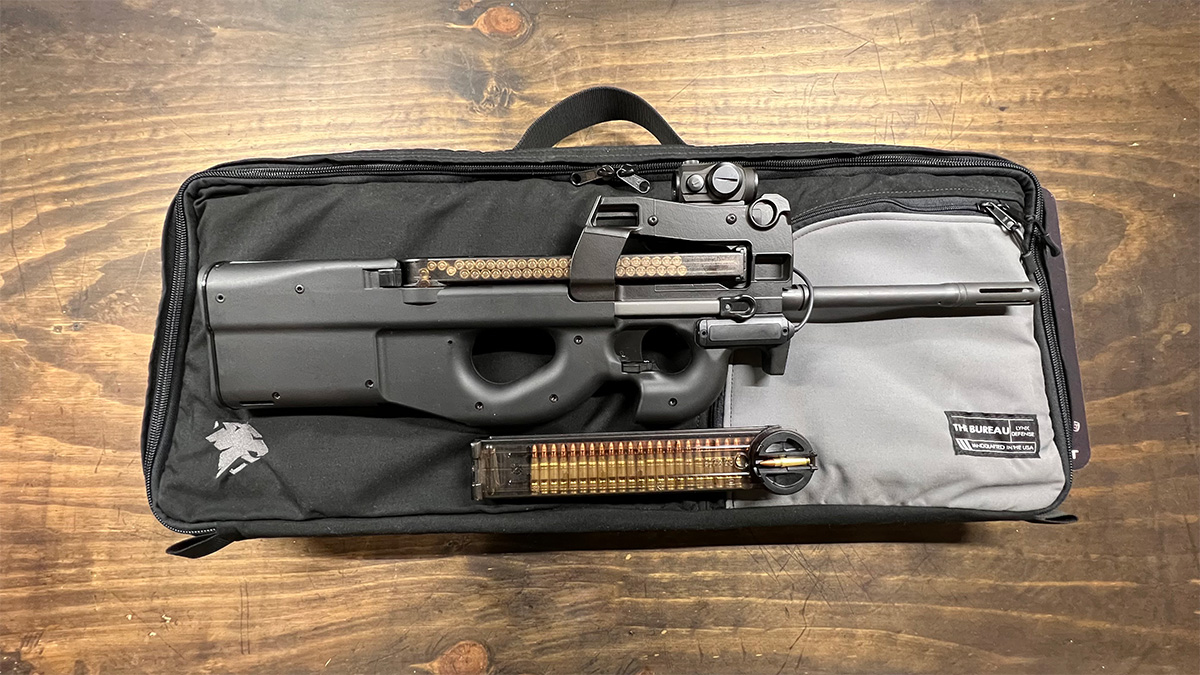
We may earn revenue from product links on this page and participate in affiliate programs. Learn More ›
The FN P90 is one of the most iconic firearms of all time, the FN PS90 is the civilian legal version of the sub machine gun, short barrel, P90.
As a product of the late 80’s, I’m at the point in my life where I’m all about the warm fuzzy nostalgia looking back at my childhood. That childhood consisted primarily of legos, ninja turtles, Nintendo, and later on PlayStation.
TV and movies and video games were a completely different vibe spanning into the early aughts, with cult classics like Walker, Texas Ranger, Home Improvement, Stargate SG-1, the Brosnan Era Bond movies (like him or not) and video games such as Battlefield, Counterstrike, and all the various James Bond titles of the era.
If you paid any attention at all during this time period to the media, you would have noticed the futuristic, almost alien-like design from FNH; the P90. What we have before us for review is the civilian version, the PS90.
Essentially, the PS90 differs from the P90 in that the full auto capability is removed and the barrel has a shroud pinned over top that brings the total length of the firearm into compliance with US law.
This strange amalgamation of plastic and metal was so different that it was included in most main titles as it immediately drew the attention of most who saw it.
It definitely drew my eye as a young impressionable child. I have always been drawn to “different” or alternative designs in firearms and find myself often making unconventional choices when it comes to my personal purchases.
It was for that reason that when my interest turned back to the FN PS90, the civilian available version of the now iconic FN P90, I knew I needed to snag one.
My primary driver was Stargate SG-1. I rediscovered the series a few months back and it lit the fire for the PS90 and its little 5.7x28mm cartridge.
Let’s dive into some of the FN PS90 details.
One of the driving factors for NATO requesting a small, compact side arm replacement was size. There were two firearms that the FN P90 was designed to replace. The M16 rifle and the M9 pistol.
FN decided the easiest way to get the compact size that was required was to go with a bullpup design. At the time, this design was relatively new, and not many other manufacturers had ventured into the bullpup design. This is one of the reasons the P90 or PS90 is so iconic.
For many people this was one of the first bullpup designs that they saw.
What does PDW stand for? PDW simply stands for Personal Defense Weapon. Now that we have that out of the way, what does a Personal Defense Weapon do? At the most simple level, a Personal Defense Weapon allows the user to defend their person.
For rear troops, such as cooks, truck drivers, mechanics and basically anyone not on the front line, a smaller lighter weapon than a full size rifle would be beneficial. The M9 pistol is obviously smaller than the M16 rifle, but it has several limitations such as barrel length and caliber.
A shorter barrel generally means lower accuracy and less powder burn. This is a universal draw
back of pistols in general.
This made the design choice for a bullpup make more sense to the engineers. Compactness, lethality and portability were all high on the demands for NATO.
Armor penetration was another major driving factor.
The SS109 or M855 cartridge was a real zinger when shot through the 20 inch barrel of a M16, but as discussed earlier, the need for a more compact weapon severely limited the 5.56x45mm cartridge.
Today you see a lot of “M4 ” variants sporting 10.3” or 10.5” barrels, but when you cut the desired barrel length nearly in half, you end up losing a lot of potential power of the cartridge.
Even though this is the route that the United States would end up taking, it still has its drawbacks. Overall size and weight being chief among them.
When you look at the caliber the M9 pistol is chambered in, you quickly understand that it too has drawbacks. Although 9mm is the most popular pistol caliber in the free world, its performance against “hard” targets is very anemic.
The Brits would end up submitting an alternative chambering that would somewhat address the armor penetration issues but it would not turn many heads of the people that would ultimately make the decisions.
The Russians, the very ones this PDW was designed to potentially fight, would also develop a 9mm cartridge that had armor penetration capabilities, however limited they may be.
FN decided to hit the drawing board and came up with a new cartridge; the FN 5.7x28mm.
Some people claim that the 5.7x28mm is nothing more than a .22WMR, they would be incorrect.
The 5.7x28mm developed for the FN P90 (and the FN Five Seven) would take on a look of the more modern rifle round. It was given a bottleneck design that many are familiar with, but it had no parent cartridge, so the design work was all up to the folks at FN.
The brass cases were coated in a thin polymer layer to help feeding in the P90 and PS90 because of the design of the magazine. We will cover why that became essential later on in this article.
FN was not the only manufacturer to make a submission for the PDW trials requested by NATO.
FN was actually the new kid on the block when it came to this segment of the firearm industry. The reigning champ for the past few decades had been the German HK MP5. Some would still argue that the MP5 is the king of sub-guns, and you can read about the Century Arms AP5P.
The HK MpP5 however had grown a little long in the tooth, and as discussed above the 9mm and even .40 S&W / 10mm chambering left the king sub-gun with less than what was needed to achieve the goals of the PDW contract.
HK would introduce the 4.6x30mm in the HK MP7 to go against the 5.7x28mm from FN in the P90.
The 5.7×28 and the P90 would consistently get better marks than that of the 4.6×30 and the MP7, but as a member of NATO Germany would ultimately skuttle the rest of NATO’s plans for the adoption of the 5.7×28 and the P90 as the new PDW cartridge and firearm by voting for their domestically engineered and produced 4.6x30mm in the MP7.
This would not be the first time something of this sort would happen in a NATO trial (Looking at the good ole USA with the 5.56×45 and the 7.62×51.)
Eventually, both the 5.7x28mm and the 4.6x30mm would be adopted as standard service.
There is just something that keeps pulling me to the unconventional bullpup design. Most of them look hideous and have horrendous triggers and lackluster ergonomics. Even so, I’m almost instinctively drawn to them.
The P90 and PS90 seem to take care of a lot of these perceived shortcomings in its design.
The curvaceous grips give a sleek futuristic look to the weapon seldom seen elsewhere in the gun industry.
The polymer that the lower is constructed from is a far cry from the squishy, cheap feeling of the various bullpup offerings from Keltec that we’ve reviewed before. Even though the P90 uses a similar clamshell design for the lower, it feels like quality in your hand.
The overall barrel assembly on a PS90 is 18” inches. This includes the barrel shroud that is needed for compliance with the OAL length requirement of 26”. Included on the barrel shroud is a flash hider that somewhat resembles a birdcage style.
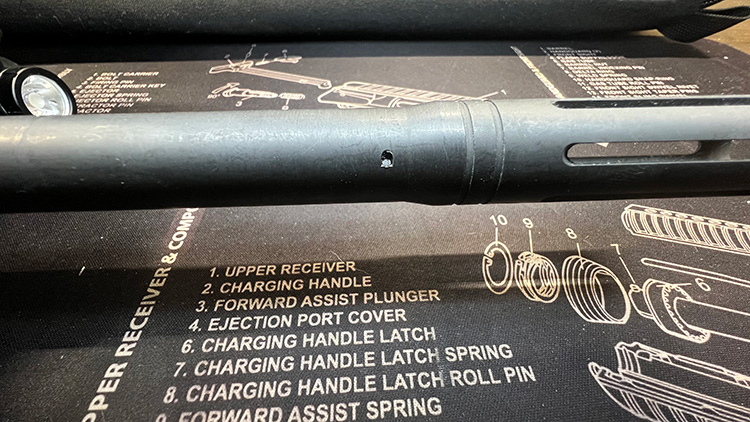
There are six ports that encompass the entirety of the flash hider. Most traditional firearms have a barrel length of 16” and don’t have to worry about the OAL clause because of their longer length, but because the FN PS90 is a bullpup these other regulations come into play.
The threaded portion of the PS90 barrel is 16”. The barrel shroud is pinned onto the barrel and is needed for the assembly and proper function of the firearm.
As with other bullpups, the trigger mechanism gets a little complicated when in comparison to a more traditional-styled firearm such as an AR15. The trigger itself is located near the front of the firearm and is large and plastic in design.
This trigger is linked to a trigger bar that runs parallel and under the barrel back through the lower and into the stock portion of the PS90. There you will find a trigger pack that contains all the actual working mechanisms that make the PS90 go bang.
The trigger pack can easily be removed from the rifle and is self-contained. The majority of its parts are plastic, which gives for some pause but there have been no major issues that were noted in the original development of the P90 which as we know is a full auto and short barrel variation of the PS90. Being made of primarily plastic parts helps to keep the overall weight down on the PS90.
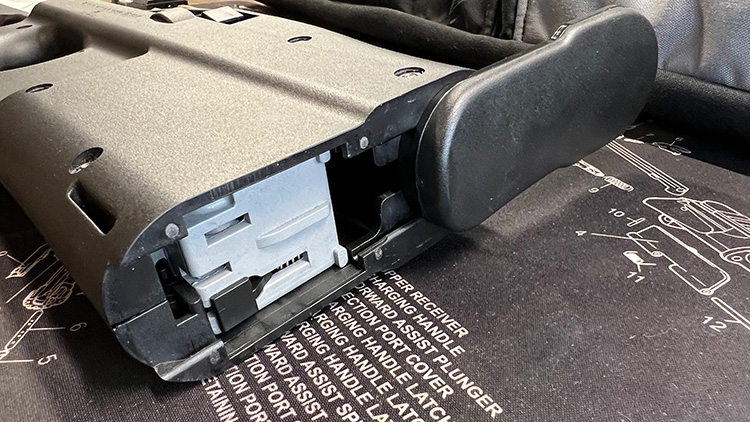
There are three major types of trigger packs, but no real definition or notation for when they were changed. The most desirable of these would be what is considered the “first generation.” Without going into too much detail, the first-generation PS90 trigger packs are so desirable because of the striking similarities to the trigger packs found in the P90.

If you have an original P90 from the early years, it might be worth your while to look into if you have this trigger pack or not. If you do, hold on to it tight, lol.
The ergonomics of the PS90 are as unique as they come. If you are used to handling more traditional rifles such as the AR or even AK’s when you first get to put your hands on a PS90 it will feel forein to you.

The curves and rounded edges found across the platform though, are quite comfortable once you get used to handling the PS90. I toted the PS90 around with me for a weekend after my wife and I put our kids to bed for the night. After the first night, I began to notice that the awkwardness started to disappear. By the second night, it began to feel like second nature.
The PS90 is balanced well, as the majority of the weight is over the centerline of the firearm.
The weight is a little high up, being that the upper is primarily metal, including the receiver and barrel assembly.
There is no real texturing on the PS90 to speak of. This is one small complaint one could articulate if you chose to do so. The polymer isn’t necessarily smooth per se but I personally think the PS90 could use a little texture in some key areas to aid in retention.
Redundancy is king.
The PS90 has two iron sights built into the receiver bridge. They can be found at each top corner, and resemble a post and notch style sight. These iron sights are crude and are by design offset from the barrel. They will however get the job done if you were to need them within 100 yards or so.
Over the years the sights found on the PS90 and the P90 have evolved. Originally the PS90 came with a Ring Sight reflex sight. The Ring Sight consisted of a dot and ring. It was a decent sight for the late 80’s early 90’s but soon technology would surpass it.
There was a model released that had a tri-rail. The rails were located at 12, 3 and 6 o’clock positions. This allowed for mounting of more modern sights and also the use of lights and lasers that utilized the M1913 style rail.
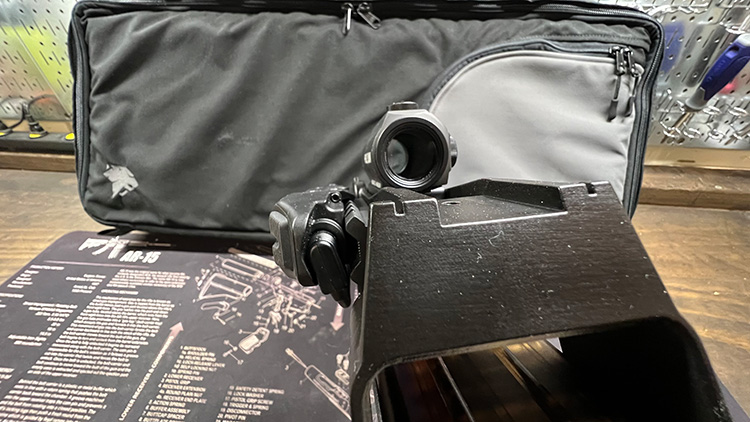
In its current factory setup, the PS90 comes with a large aluminum block that has 1913 rail only located at the 12 o’clock position. This large block of aluminum does have another integrated peep-style “iron” sight built in that utilizes an AR style pin front sight.
I found that mounting a red dot on top of this large block of aluminum meant that I would have to place my chin on the stock of the PS90 instead of my cheek and quickly ordered a replacement for the OEM sighing system.
Generally speaking, the controls of the PS90 are intuitive even though they are not conventional in any sense of the term.
The safety found on the PS90 and the P90 is shared by only one other firearm to my knowledge, and that firearm is also a bullpup designed by FN, the FS2000. The switch is rotary in design and thus is ambidextrous. If you are shooting right handed, to engage the safety you push the dial toward the front of the firearm. To disengage and make ready to fire, you pull the rotary dial back to the rear of the firearm.
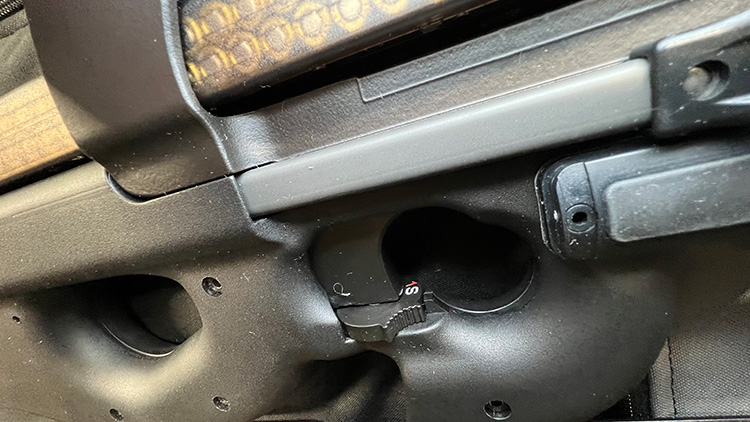
For left handers it’s just the opposite. To make it ready to fire you will push the rotary to the front, and to make it safe, you will pull it to the rear.
As with any firearm, you should make sure you are familiar with its operation before you go to shoot it. Since the PS90 is such a unique firearm, take a little extra time to familiarize yourself or others that may shoot the firearm with you.
You won’t win any medals for quick magazine changes with the PS90. The magazine is located on top of the frame and sits parallel to the body of the firearm. The magazine release is located just behind the chamber and is also ambidextrous.
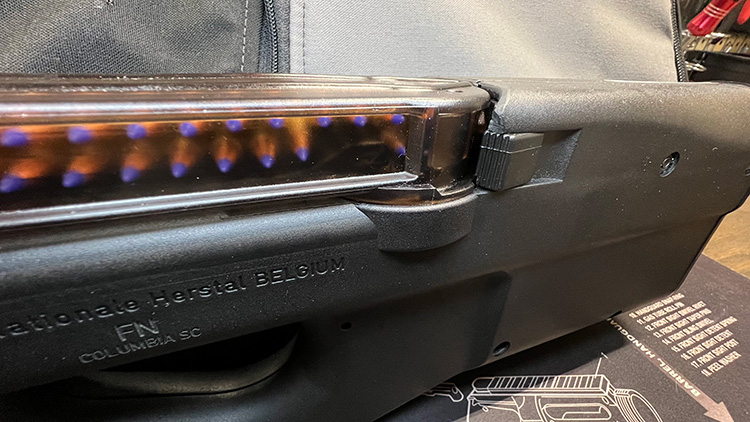
There are two tabs, one on each side of the PS90 that you will need to activate to release the magazine from the gun. You can use just one if you choose, but I find that using a grip over the top of the mag in anticipation of removal places my finger in line with both tabs.
Once activated the mag pops up from the chamber in a positive manner. From there you simply grip the magazine and remove it out from the guide rails/sight tower.
To replace the magazine, you will slide a new one in and give the rear of the magazine a firm smack with the palm of your hand or your fist. No need to be careful with inserting the magazine as this may cause the magazine to not fully seat down into the chamber.
Once the magazine is fully seated, you will need to charge the PS90. Here again the PS90 boasts its ambidextrous nature. There are two charging handles to be found on the lower frame of the firearm. They are located almost in line with the barrel, and toward the front of the frame.
The charging handles operate the direct blowback system and are non-reciprocating. The interface is smooth polymer and is the only part of this PDW that feels cheap. The handles could use a little larger interface and maybe some checkering.
The FN PS90, like any gun, needs some accessories to make it the complete package.
One thing the current PS90 is sorely lacking is rails. To keep the general form factor of the PS90, there are a few options available.
They can be found from a few manufacturers including FN themselves, but I chose to go with a rail offered from Design Machine. They are a machine shop that turns out quality products for the PS90 and P90.
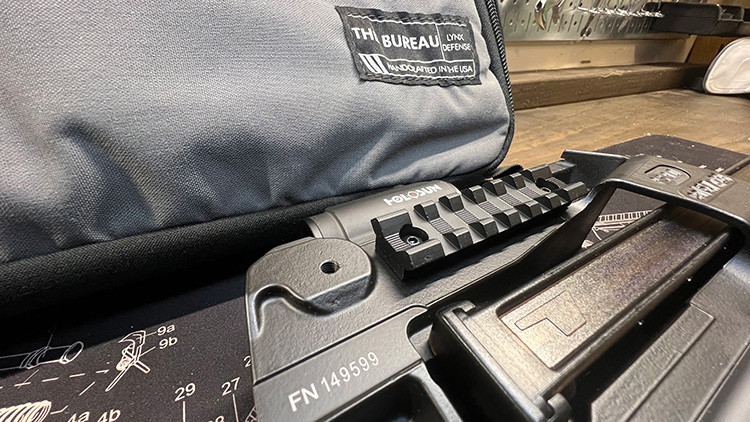
Any light that mounts up to a 1913 rail can be used, but because of the location of the rails on the PS90 I prefer to keep the light tucked up tight. To do this, I chose to mount up a Streamlight TLR-RM2 to the rail on the left side of the PS90’s sight tower. I like the form factor that the TLR-RM2 provided.

With the up high location of the rail, the on board switch for the TRL-RM2 would not work for this application. I opted to use the tape switch that comes along with the Streamlight. I routed the wire down underneath the body of the Streamlight and around the front of the P90.
I then attached the tape switch to the front portion of the lower frame just above the forward grip. I found this allowed me ease of use when shooting with either hand and kept the manipulation away from my trigger hand which is ideal.
The only thing you have to make sure of is to unplug the tape switch from the back of the Streamlight before you separate the two halves of the PS90.
As discussed briefly earlier, the supplied optic mount is very large and cumbersome. The very first thing I customized on the PS90 was removing the supplied rail and ordering a low profile mount from Design Machine.
Here again Design Machine makes a quality product that moves the optic down to a usable height for most.
This also brings the height over bore to a more reasonable level. If you previously sighted in your PS90 before mounting an optic with the Design Machine mount, you may want to sight in your PDW again.
There are a few other options for mounting optics, but none seem to be the same quality of the Design Machine mounts.
Sling options are limited with the unique design found on the PS90. You can find a few options online, but I have not decided on that quite yet. If you want to keep things how they were originally meant to be, you can opt for something from Urban ERT Slings or a three-point option from The Vest Guy. Options can also be found on Amazon.com
Oddly, the magazine that comes with your PS90 is limited to either 30 or 10 rounds.

This is odd because the standard capacity is 50. This is solved easily enough though.
There are two main ways to get this done. One is to cut the block out of the magazine. Anyone who is somewhat competent and has a coping saw or some other kind of means to remove a bit of plastic can get this done.
The other option is to purchase a Spring Plate Adapter and simply remove the spring from the blocked one in the mag and attach it to the adapter. This was the route I went and have not had any issues.
Shooting the PS90 is a dream. The recoil, even though it is direct blowback, is so minimal it’s laughable.
You can easily one hand the PS90 and keep it on target. The hardest thing about shooting the PS90 is the pain you will feel in your wallet as the 5.7x28mm rounds are at or near $1.00 a pop. This is also a minor complaint, but if you can afford a niche gun like the PS90, you probably aren’t too concerned with ammo prices.
My intention with the PS90 was always to try to get it to it’s original SBR form and as close to the P90 as possible.
When my stamp came back I picked up the CMMG barrel and adapter and made it happen. I paired mine with the Rugger Suppressors Oculus 22 and it was well worth it! Check out this video of the difference.
The PS90 is an instant classic with its space-age looks.
I love the handling and portability of the FN PS90. Although it features a somewhat rare cartridge I feel it fills a void in my collection and I enjoy shooting and showing it off to anyone who is interested… and it will definitely turn heads at the range!
It joins a few others in my safe on the list to SBR. Keep an eye out for that update soon. If the PS90 isn’t your flavor of bullpup rifle than take a peak at our full list of best bullpup rifles.
If you like FN’s be sure to take a peak at the FN 509 and FN 509 Tactical pistols for everyday carry.
As a weapon that was designed as a PDW from the ground up, the PS90 excels at personal defense.
As equipped by the factory, the FN PS90 is not legal in California. Modifications can be made however to bring it into compliance, including a limited magazine and thumb hole blocker.
The FN PS90 is manufactured by FN Herstal in Belgium.
The FN PS90 is a uniquely good gun that is fun to shoot and draws a lot of eyes as it has been featured prominently on screens in movies, on TV, and video games throughout the years.
Essentially, the PS90 differs from the P90 in that the full auto capability is removed and the barrel has a shroud pinned over the top that brings the total length of the firearm into compliance with US law. The P90 is a short-barrel rifle by US law standards and the PS90 is a “full-size” rifle.
Great review and thank you for providing so much information about the development of the weapon as well as the round and especially the aftermarket links.
Wow, such an excellent review of this weapon. I really liked the 80’s nostalgia:))) By the way, I put a PS90 in layaway today! So thank you for the confirmation of my decision 🙂